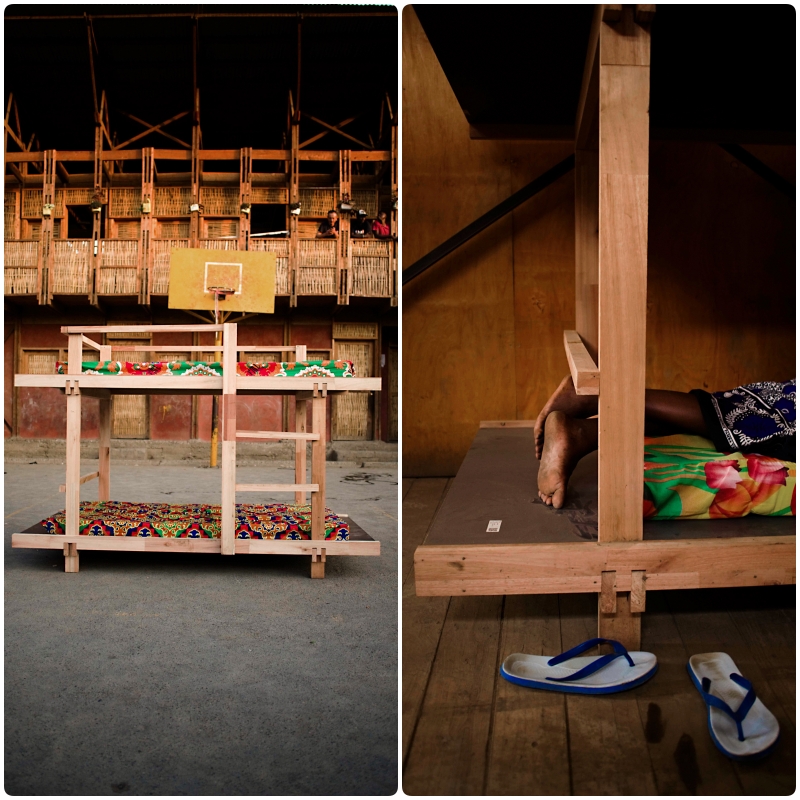Assab One, a Community-Focused Photographic Project at Salone
During the Salone del Mobile Milano, the entire design community is on activation mode and organises art and design related projects. Some put up projects and programmes that touches the community and focuses on initiatives that integrate different languages capable of reaching beyond the art world. Elisa Carassai looks at Assab One, such a nonprofit organisation that intergrates design and art to present “Design for communities,” a wood furniture exhibition project with a cause.
Up north, in one of Milan’s up-and-coming art districts, lies Assab One, a nonprofit organization founded by Elena Quarestani that aims at providing artists with a non-conventional environment for research and expression.
Housed inside an industrial building that used to house a printing company, Assab One has, ever since its opening, worked on cultural programming, producing and promoting exhibitions, events, and art projects focusing on initiatives that integrate different languages capable of reaching beyond the art world.
For this year’s Salone, the cultural melting pot is presenting “Design for communities,” a wood furniture exhibition project about integration, originated between Ngo Liveinslums and designer Giacomo Moor and curated by Federica Sala and Davide Fabio Colaci.
“A few months ago, I talked with Elena about the next edition of 1+1+1 (a project I had been curating for Assab One since 2016). We both felt the project needed a breakthrough or a break. But at the same time, we didn’t want to give up on the dialogue and collective dimension that characterised it, and that has always been the soul of that unique place, Assab,” recounts Federica Sala. “While we were in this limbo, Live in Slums arrived on the table.”

The unfolding of the human story at Mathare alongwith its complexity of relationships visible through the images created by four exceptional photographers at Assab One.
The project originated when designer Giacomo Moor traveled to Mathare to make furniture prototypes for the dining hall and dormitory of the Why Not Academy, a local school that accommodates about 300 children. The making of benches, tables, and beds took place together with the Mathare children, allowing them to learn new techniques, get paid for their work, and at the same time, create furniture of high formal and functional quality for a more conscious design.

Image by Filippo Romano. “In this analytical and emotional interpretation, Mathare seems to take a form that reaches beyond the moment of the shot to insert itself back into a broader rhythm that transcends the photographer’s gaze and gets straight to its essence,” according to Davide Fabio Colaci.
“The invitation from LiveinSlums to design furniture for the dining hall and dormitory of the Mathare primary school, one of the largest Slums of Nairobi, was a unique opportunity to implement a research process that has been with me for some time. The specific request of making prototypes on site together with the school’s students, allowing them to be fully autonomous for subsequent production, triggered a design logic based on production simplification,” explains Moor.
The collection was then turned into a photographic exhibition, curated by Davide Fabio Colaci in collaboration with Federica Sala and Perimetro, a photographic reality based in Milan. Working with four incredible Italian photographers, Francesco Giusti, Filippo Romano, Alessandro Treves, and Mattia Zoppellaro, the exhibition takes the audience on a journey across each photographer’s stylistic codes, which have interpreted places, atmospheres, architecture, and characters, bearers of a rich but elusive sense of community.
“Their photos do not require any demarcation of a gender other than that of representing a mosaic of emotions and ambiguities from a country that has no borders when it comes to its human energy. Abandoning the purely documentary aspect, the details, materials, expressions, and colours that belong to the slum seem to contain a potential energy far superior to their material reality. And in this analytical and emotional interpretation, Mathare seems to take a form that reaches beyond the moment of the shot to insert itself back into a broader rhythm that transcends the photographer’s gaze and gets straight to its essence,” commented curator Davide Fabio Colaci.
A powerful exhibition, which will strike its audience because of its delicate gaze on a sensitive topic, which may be one of the visual and intellectual highlights of this whole Fuori Salone.
All Images Courtesy of Assab One.









